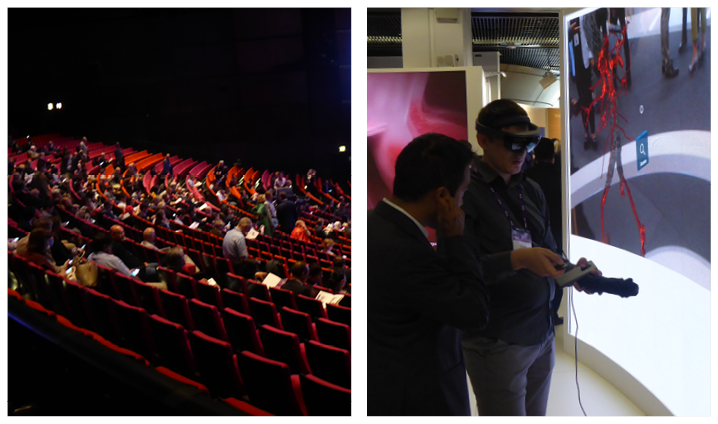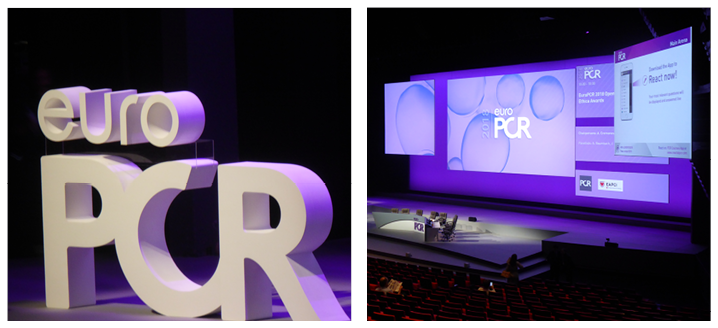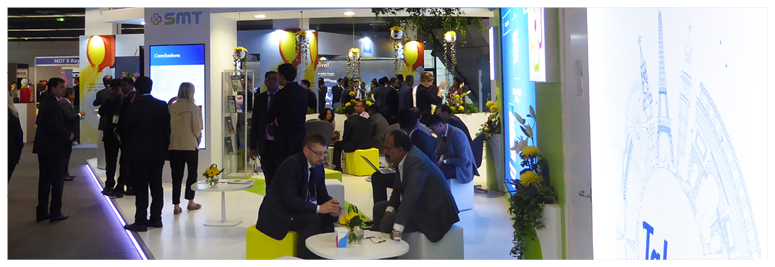Nearly 11,000 participants from all over the world arrived at the heart of Paris, France for EuroPCR 2018. Torrential rain failed to put a dampener on the event, and the burgeoning storm outside was matched by the electric atmosphere crackling within the Palais des Congrès.
A myriad of opportunities were waiting to be seized from the outset of this inimitable event. In front of a packed audience inside the Grand Amphithéâtre, Prof William Wijns and Prof Jean Fajadet introduced the event at the opening ceremony, praising its incandescent programme and reiterating the event’s goal of improving patients’ lives. The ceremony also provided a wonderful platform to celebrate the prestigious Ethica Award, which was this year awarded to Dr François Bourlon and Dr Philip Urban for their work in establishing cathlabs in regions of great unmet need: Mauritania and Nepal, respectively. Philippe Urban concluded his acceptance speech with a poignant call to action, urging the interventional community to keep striving to expand the reach of their life-saving treatment.
With the event begun in earnest, delegates were treated to an extensive programme featuring a plethora of session formats, including live sessions, workshops, and plenary lectures. Navigation was facilitated by the EuroPCR app, which allowed visitors to keep abreast of the online schedule and all the latest news.
Among the highlights of the many scheduled events were the gripping live sessions on offer from all over the world, including Bahrain, China, France, Germany, and the UK. These sessions offered an amazing learning opportunity to attendees, who could ask questions directly to the operators via the EuroPCR app while the interventionalists dealt with the cases, complete with complications, in real-time. Technology is rapidly evolving in the world of interventional cardiology, but these live sessions reminded viewers from around the world that at the heart of the discipline remains a singular, potent tool: clinical technique.
A great focus of this event was on the training and showcasing of young interventionalists. The European Association of Percutaneous Cardiovascular Interventions (EAPCI) Fellows Course allowed young interventionalists to interact with giants of the discipline in a welcoming and unique fashion, laying the groundwork for future collaboration between generations. In a competition dubbed ‘PCR’s Got Talent’, young doctors had the chance to hone their presentation skills in front of their peers, sharing their research in rapid-fire 3-minute sessions. Winners from each session were selected, ultimately competing head-to-head to be crowned this year’s champion.
Presentation skills were not the only area in which attendees could improve themselves at this congress. A comprehensive training village gave attendees, young and old, the opportunity to take their skills to the next level. For the first time, simulation-based learning sessions for bail-out techniques were available, allowing doctors to practise the vital techniques with the help of cutting-edge technology. Another unique opportunity took the form of interactive picture sessions, entitled ‘An Image is Worth 1,000 Words’, in which cryptic pictures from interesting cases were presented, with the audience invited to diagnose them collectively.
Naturally, the congress was brimming with the latest research and there were plenty of late-breaking trials for delegates to sink their teeth into. The much-anticipated results of the SPYRAL HTN-ON MED trial were one such highlight, showing renal denervation to be an effective therapy for uncontrolled hypertension in patients with a background of commonly prescribed antihypertensive medication. In combination with the results from the SPYRAL HTN-OFF MED trial, these results indicate a promising future for renal denervation as a hypertensive therapy option and warrant larger clinical trials.
EMJ Interventional Cardiology 6.1 brings you all of EuroPCR’s most vibrant highlights in the following section, and we hope that the content within satiates your appetite for striking research and provides a thorough overview of the event for those who could not attend this year. Paris remains the home of interventional cardiology for EuroPCR 2019, taking place on the 21st–24th of May, and the EMJ team looks forward to sharing that adventure with you next year.

Statement on Treatment of Chronic Coronary Syndromes
“UNTIL now, the prognostic role of percutaneous coronary intervention (PCI) in patients with chronic coronary syndromes is still unclear and [has] been questioned. Modern drug-eluting stent (DES) technology and better identification of ischaemia-driving lesions has helped to improve results. Important new data released during EuroPCR 2018 now strongly support the positive role of PCI in the treatment of chronic coronary syndromes.” These were the words of Prof Michael Haude, President of the European Association of Percutaneous Cardiovascular Interventions (EAPCI), commenting on the PCR statement on chronic coronary syndromes, which was reported in a EuroPCR press release, dated 22nd May 2018.
Chronic coronary syndromes reduce physical endurance, can cause depression, and often require recurrent hospitalisation. Consequently, they have a significant impact on patients’ quality of life. Recently, the results of new trials, many of which were presented at EuroPCR, have provided evidence supporting the use of PCI with the newest generation of DES for the treatment of chronic coronary syndromes. Previous trials that had shown limited evidence had not tested the latest generation of DES.
The PCR statement highlighted the results of several trials, including:
- ORBITA
- GZ-FFR
- FAME 2, DANAMI-3-PRIMULTI, and COMPARE-ACUTE
- Results from the Swedish Coronary Angiography and Angioplasty Registry (SCAAR)
The PCR statement highlighted several points of guidance for treating chronic coronary syndromes. Firstly, in comparison to medical treatment alone, the use of PCI as a treatment modality resulted in fewer spontaneous myocardial infarctions, fewer urgent revascularisations, fewer instances of angina, and an improved quality of life. The statement also explained that, in terms of mortality, stent thrombosis, and restenosis, fractional flow reserve/instantaneous wave-free ratio, physiology-guided PCI was superior to angio-guided PCI; this superiority remained for up to 10 years. It was noted that PCI demonstrated a greater benefit when there was a lengthier post-PCI observation period and also for coronary lesions with a greater degree of ischaemia. Indeed, the greater the degree of ischaemia noted for a coronary lesion, the greater the benefit of PCI. It is hoped that the release of this statement, in conjunction with the presentation of trial data, will provide valuable insight for medical professionals when they are considering the treatment of chronic coronary syndromes.
Pooled Data Show Stents Reduce Risk of Future Heart Attacks
FRACTIONAL flow reserve (FFR)-guided percutaneous coronary intervention (PCI) offers better hard outcomes than medical therapy for stable coronary lesions, according to a late-breaking trial, the results of which were revealed in a press release presented at EuroPCR 2018. These results from the first patient-level pooled analysis add to the ever-growing discussion regarding the role of PCI for improving patient outcomes for stable coronary lesions.
The results from this first-of-its-kind pooled analysis of three Phase III trials showed a relative-risk reduction of ~30.0% when using FFR-guided treatment compared with medical therapy for stable coronary lesions, including stable coronary artery disease and non-culprit lesions in haemodynamically stabilised acute coronary syndrome; this correlated to an estimated risk reduction of ~4.5% at 5 years. The analysis of this pooled data, totalling 2,400 patients from the FAME 2, DANAMI-3-PRIMULTI, and COMPARE-ACUTE trials, showed, for the first time, that PCI, when coupled with FFR, reduces a patient’s risk of hard endpoints, including cardiac death or myocardial infarction.
Each trial individually highlighted that FFR-guided PCI was favoured; however, none of the trials were powered for the endpoint of cardiac death or myocardial infarction. When pooled, this data was sufficiently powered to assess that FFR-guided PCI reduced the composite outcome of cardiac death or myocardial infarction when compared with medical therapy.
Dr Frederik Zimmermann, Catharina Hospital, Eindhoven, Netherlands, explained the pivotal impact these results will have on improving cardiac patient outcomes: “Medicine has two broad goals: making you feel better now and avoiding problems in the future. Widening narrowed heart arteries with stents has long been used to treat symptoms and stop ongoing heart attacks. However, whether stents can help avoid problems in the distant future has remained controversial. Pressure measurements inside the heart arteries can identify coronary arteries that should be widened. Our results show for the first time that stents reduce the chances of having a future heart attack in clinically stable patients with such arteries.”

Analysis of the ORBITA Trial Results
OUTCOMES from a physiology-stratified analysis of the ORBITA trial were presented at this year’s EuroPCR. These summarised the main clinical implications of percutaneous coronary intervention (PCI) in stable angina and single vessel coronary artery disease patients and the predictive value of fractional flow reserve (FFR) and instantaneous wave-free ratio (iFR). Reported in a EuroPCR press release dated 22nd May 2018, this stratification of ORBITA trial results provides the first placebo-controlled evidence of its kind.
During the analysis, invasive physiology data from 196 ORBITA trial participants were assessed to investigate the FFR and iFR predictors of the placebo-controlled efficacy of PCI. At pre-randomisation, 150 of 196 patients had Canadian Cardiovascular Society (CCS) Class II or Class III symptoms. Response variables, treadmill exercise time, stress echocardiography score, symptom frequency, and angina severity were assessed at pre-randomisation and blinded on follow-up, and the effects were determined via analysis of covariance.
Stratification by invasive haemodynamic measures of stenosis and severity successfully demonstrated an association between FFR and iFR and the benefit of PCI. Looking at the results, the placebo-controlled effect of PCI was more clearly visible by stress echocardiography score and freedom from angina than change in treadmill exercise time. PCI improved stress echocardiography score more than placebo (1.07 segment units; 95% confidence interval: 0.70–1.44; p<0.00001), and this increase correlated with decreases in both FFR and iFR. Commenting on the significance of this result for physicians, Dr Rasha Al-Lamee, ORBITA principal investigator, Imperial College London NHS Healthcare Trust, London, UK, explained how it will now be possible to use iFR and FFR data to predict improvements in ischaemia as a result of stenting, even before the procedure.
In addition, more patients reported freedom from angina following PCI compared to placebo (49.5% versus 31.5%; odds ratio: 2.47; 95% confidence interval: 1.30–4.72; p=0.006); however, FFR and iFR did not modify this effect. The researchers noted that achievement of this secondary endpoint by patients increased by 20 absolute percentage points following angioplasty, meaning that one in five patients who are treated with angioplasty versus placebo will be more likely to be free from angina. “For patients, this is one of the most important things we can tell them, that they are more likely to become symptom-free,” elucidated Dr Al-Lamee.
Overall, this analysis highlighted the predictive value of FFR and iFR in determining the placebo-controlled PCI effect on ischaemia. With this effect most clearly visible using stress echocardiography, the researchers noted that the next steps will investigate the extent to which this imaging technique itself predicts the impact of PCI. To apply these results to a wider patient base, preparations are now underway for a larger second ORBITA trial to include more patients with stable angina, with the hope of improving outcomes for many more PCI patients.
A Physician’s Thought Process: Results from SYNTAX III
COULD non-invasive procedures replace cineangiography in heart team decision-making? The SYNTAX III trial aimed to develop a better understanding of the decision-making process of physicians, and its hotly anticipated results were unveiled in a EuroPCR press release dated 22nd May 2018.
Cardiac specialists from six international medical centres were enrolled in the SYNTAX III Revolution trial; the distinguishing feature of this trial was that the study co-ordinators randomised the physicians, not the patients, into two teams. The recruited surgeons, interventional cardiologists, and radiologists from each clinic were asked to diagnose and develop treatment plans for 233 clinical cases over an 18-month time period; each heart team saw the same cases. The heart teams had to consider several factors, including which vessels had to be revascularised, how many bypasses would be required, and how many stents should be used. The key area investigated was whether the teams chose to treat with surgery (coronary artery bypass graft) or percutaneous coronary intervention. The difference between the two teams was in the information available to them in determining their treatment approach: Team A could only use information available from non-invasive methods, such as multislice coronary computed tomography angiography and CT assessment (HeartFlow® Analysis, HeartFlow Inc., Redwood City, California, USA), whereas Team B used information from conventional cineangiography.
The decisions of the two heart teams were compared using Cohen’s kappa statistical tests. Agreement between the two groups was very similar: “…the Cohen’s kappa statistic was very high, 0.82, which can be called an almost perfect assessment/agreement,” explained Prof Patrick W. Serruys, study Chairman, Imperial College London, London, UK. He added: “[Cohen’s kappa statistic] showed good agreement as well in terms of the number of bypasses, how many stents should be used, and the location in the coronary circulation.” Furthermore, the heart teams reported that the noninvasive diagnostic techniques provided a much clearer image of the patient’s condition than the conventional techniques.
The main take away from the SYNTAX III Revolution trial is that noninvasive diagnostic techniques were found to be very useful. With the continued development of noninvasive diagnostic techniques, the future looks promising for these less invasive technologies; in fact, Prof Serruys predicted that within 5–10 years, noninvasive methodologies could have surpassed their conventional counterparts.

Presenting the EAPCI White Book
INTERVENTIONAL CARDIOLOGY practices from a range of countries have been documented in a first-of-its-kind survey and presented at EuroPCR 2018. According to a EuroPCR press release dated 22nd May 2018, the European Association of Percutaneous Cardiovascular Interventions (EAPCI) White Book describes the results from a 2016 survey that collected data on aspects such as treatment implementation and resource allocation. With the hope of delivering cutting-edge cardiovascular care for all patients, the data underlines major healthcare gaps and inequalities.
Data were collected on the practice of interventional cardiology by representatives of national cardiac societies and working groups under the leadership of Prof Michael Haude, EAPCI President, and in collaboration with the European Society of Cardiology (ESC) Atlas of Cardiology. The 16 countries involved were Belgium, Denmark, Egypt, France, Germany, Greece, Italy, the Netherlands, Poland, Romania, Slovenia, Spain, Sweden, Switzerland, Turkey, and the UK.
With regard to interventional procedures, the data highlighted that most countries surveyed were delivering ≥500 primary PCI procedures per million inhabitants, which was the target set by the EAPCI primary PCI implementation programme, ‘Stent – Save a Life!’ For example, PCI by insertion of a radial artery catheter and using drug-eluting stents where indicated was performed in >50% of PCI procedures in the majority of participating countries (>3,000 procedures per million people). However, some countries reported low numbers of patients treated with drug-eluting stents, suggesting there may be some implementation barriers to this method. The survey also showed that transcatheter aortic valve implantation and other similar structural treatment interventions are becoming more popular in the clinic, although discrepancies in reimbursement policies among the countries involved meant that the use of these therapies was not consistent.
Additionally, looking at resource allocation, the extensive survey results showed a vast variation among the included countries, suggesting focus is required on standardising resources among ESC member countries. For example, the number of hospitals with operating rooms for catheter-based procedures ranged from <2 to >5 per million people, and the number of interventional cardiologists per million people ranged from 10 to >25. By highlighting these differences, lead author Prof Emanuele Barbato, Cardiovascular Research Center Aalst, Aalst, Belgium, described how the EAPCI White Book will enable healthcare payers and regulatory bodies to re-evaluate interventional cardiology resource allocation across Europe, and allow industry bodies to invest in specific clinical needs.
“The EAPCI White Book is an important companion to the ESC Atlas of Cardiology, providing more in-depth information on this rapidly growing domain in cardiology,” commented Prof Panos Vardas, senior author of the ESC Atlas of Cardiology and ESC Past President (2012–2016). The authors noted that future surveys will include more ESC member countries to provide a more comprehensive overview of interventional cardiology practice across the world. The EAPCI White Book was published online on 22nd May 2018 and can be accessed via an annual subscription.
Hypertension Management: New Evidence to Support Device-Based Therapy
MANAGEMENT of hypertension may soon become considerably easier, according to the results of two studies presented at EuroPCR in Paris, France, and revealed in a press release on the 23rd May 2018. The studies explored the potential of using device-based treatments to aid in therapy for hypertension.
The prevalence of hypertension is increasing dramatically, with >1 billion patients currently known to be affected around the world. Despite best efforts, and the availability of safe and reliable drugs to help manage the condition, patients become and remain nonadherent; for half of patients, this occurs within the first year of starting drug treatment, and around 20% of patients are nonadherent from the start. Previous clinical trials have highlighted these issues and also observed that the levels of adherence gradually worsen as patients are required to take more drugs to manage their condition.
The use of device-based treatments aims to improve this adherence and provide new treatment options, and, in this regard, there is a current focus on renal denervation (RDN). RDN has previously been shown to improve hypertension, even in those patients not taking any antihypertensive drugs. One particular advantage of device-based treatments and subsequent RDN, is that they are ‘always on’, even when the effects of antihypertension drugs begin to subside, for example, in the morning.
Two new clinical trials have provided further evidence that device-based therapy can help with controlling renal nerve activity and therefore lower blood pressure. The first, the SPYRAL HTN-ON MED study, used a radiofrequency device in combination with antihypertension drugs. The second, the RADIANCE-HTN SOLO study, used an ultrasound catheter to enforce RDN. These studies are vital for the advancement of hypertension treatment methods, particularly in providing beneficial evidence for the use of device-based therapy, and in determining which patients will respond favourably to each technique.
Further studies will need to ascertain the parameters surrounding the procedure for successful RDN, as well as whether the lowered blood pressure achieved can be sustained. The information and evidence obtained from these future studies will improve the lifestyle of patients with hypertension, as well as reduce the risks to patients that are associated with hypertension.

Significant Outcomes of Renal Denervation
RENAL DENERVATION significantly reduces blood pressure in patients on antihypertensive medications, according to the international SPYRAL HTN-ON MED trial that was reported on at EuroPCR 2018. With many uncontrolled hypertensive patients at an increased risk of cardiovascular events and stroke, this is an important finding for the one-third of adults with high blood pressure.
By targeting the sympathetic nervous system, renal denervation therapy provides an effective therapy for hypertension. Building on the results of the SPYRAL HTN-OFF MED trial, which provided a proof-of-principle for the efficacy of this therapy for patients not taking antihypertensive medications, the SPYRAL HTN-ON MED study aimed to investigate its effects in the presence of commonly prescribed hypertension medications. This randomised, sham-controlled trial involved 80 patients from 25 sites across the world who were assigned to two groups: sham control plus medication or renal denervation plus medication. Office blood pressure and 24-hour ambulatory monitoring at 6 months follow-up were used to measure changes in blood pressure following therapy.
The study results demonstrated statistically significant and clinically meaningful reductions in both systolic and diastolic blood pressure with renal denervation; the 24-hour ambulatory monitoring results showed a -9.0 mmHg change in systolic pressure and a -6.0 mmHg change in diastolic pressure from baseline following renal denervation (p<0.001). This trend was reflected in the results of the office blood pressure measurements, for which decreases from baseline following renal denervation were recorded at -9.4 mmHg and -5.2 mmHg for systolic and diastolic pressure, respectively. The authors observed a further decline in blood pressure between 3 and 6 months follow-up after renal denervation therapy, and reductions in blood pressure were recorded throughout the day and night, lasting over 24 hours.
This therapy proved to be safe, with no major safety events recorded despite the procedure extending into the renal artery branch vessels. The study authors expressed hope that the results of this trial will enhance the ongoing global SPYRAL HTN-OFF MED trial and motivate the conduction of larger studies of patients with uncontrolled hypertension on antihypertensive therapy.
Call to Expand Treatment for Acute Ischaemic Stroke
In some European countries, <1% of acute ischaemic stroke patients can be treated with mechanical thrombectomy. Even the countries with the highest number of mechanical thrombectomy specialists, such as the Netherlands, Germany, and the Czech Republic, only have the capacity to treat about 33% of patients. Due to the paucity of other efficacious treatment modalities, this gap in treatment availability represents a significant issue. However, as reported in a EuroPCR press release dated 25th May, the European Society of Cardiology (ESC) Council on Stroke and the European Association of Percutaneous Cardiovascular Interventions (EAPCI) have volunteered a solution. The details of this proposal were shared at EuroPCR 2018.
Currently, mechanical thrombectomy represents a significantly more effective treatment option for patients presenting with acute ischaemic stroke. Around half of all patients treated with mechanical thrombectomy will survive and function with normal neurological capabilities thereafter, with this figure rising to >70% if the procedure is carried out within 2–3 hours of symptoms presenting. In contrast, 75% of patients treated with clot-busting drugs either die or are severely disabled. Therefore, enabling 100% of patients to be treated with mechanical thrombectomy would greatly improve outcomes. The main barrier preventing this from becoming reality is the lack of know-how rather than a lack of infrastructure. As Prof Petr Widimsky, Chair of the ESC Council on Stroke, acknowledged: “There are interventional cardiology units in all countries in Europe and the Americas, and in most other continents. The equipment for mechanical thrombectomy is available; it is the trained specialists to perform the procedure that are lacking.”
The training required to perform mechanical thrombectomy, which is currently provided by interventional neuroradiologists, is typically around 2 years. This also represents a barrier towards achieving the capacity to treat 100% of patients. However, the ESC Council on Stroke and EAPCI have put forward a solution that could overcome both the lack of specialists and the time taken to conduct training. Prof Widimsky explained: “This situation could be solved by training cardiologists to perform mechanical thrombectomy.” Prof Widimsky went on to note that the proposal recommended that interventional cardiologists undergo 3 months of training on mechanical thrombectomy, stating that: “Many interventional cardiologists routinely perform stenting of the carotid arteries, so 3 months of training is sufficient to learn intracranial mechanical thrombectomy.” With this proposal having been put forward, time will tell if health authorities in each country accept it.

PCR Innovators Day 2018
REVOLUTIONARY transformations in healthcare, particularly cardiology, were the focus of this year’s PCR Innovators Day, which took place at EuroPCR. Clinicians, industry experts, entrepreneurs, and investors were brought together to gain insights into the bright future of interventional cardiology, one in which innovative advances, such as big data and artificial intelligence (AI), will play vital roles in clinical decision-making.
Described as being ‘on the cusp of a revolution’, cardiology will soon be transformed by the introduction of AI techniques to augment, rather than replace, clinicians, and this theme was clear throughout the PCR Innovators Day. Industry representatives described how a blend of computer and human aspects will optimise patient care; for example, AI platforms have now been created that can process ultrasound and X-ray data to diagnose aortic stenosis more effectively and consistently. In addition, a big data approach using panomics measurements has allowed the identification of a new pathogenic pathway and single enzyme involved in cardiovascular disease, creating a complete paradigm shift in coronary disease therapies.
Attendees also had the opportunity to learn about other futuristic applications, including 3D printing of patient-specific replicas of the heart and blood vessels for pre-surgery assessments, and the use of computer models to evaluate the performance of new devices preoperatively. These novel innovations may mean that cardiologists could plan and practise procedures before operating, particularly for high-risk patients, enhancing patient care and potentially improving the recovery process. Furthermore, microvascular occlusion following a serious myocardial infarction was also considered, with a new procedure described that involves the insertion of a balloon to occlude the blood flow and measurement of downstream pressure and microcirculation resistance.
With these technologies fast-approaching, and many more on the horizon, attendees were shown how we will soon be part of an era in which individual patients will be at the very heart of clinical decision-making, and the use of imaging in making diagnoses, creating training models, and virtually treating patients will be of utmost importance. “I think the striking thing for me is the breadth of innovation that’s going on across the spectrum of cardiovascular medicine,” commented Dr Bernard Prendergast, Guy’s and St Thomas’ NHS Trust, London, UK. He added: “The application of imaging science and the use of big data in the field of AI is something we need to embrace as clinicians.”
The Future of TAVI
Late-breaking trial data presented at EuroPCR 2018 showcased promising results for transcatheter aortic valve implantation (TAVI) for aortic stenosis. Sustained safety and efficacy results were achieved at 1 year in the CENTERA-EU trial, and mortality at 1 year was not associated with the prosthesis or pacemaker in TAVI patients in the REBOOT study. Furthermore, real-world outcomes of TAVI using a balloon-expandable valve showed no differences in all-cause mortality, strokes, and pacemaker rates. New emerging devices with lower complication rates mean the future is bright for TAVI.

The Stent – Save a Life! Forum
Founded on a European-wide basis in 2009, the ‘Stent – Save a Life!’ Initiative is a network of professionals interested in ST-segmental elevation myocardial infarction (STEMI) care, and this year’s forum at EuroPCR 2018 provided a vital opportunity to exchange views and learn from others from across the globe. The various challenges experienced were discussed, including those from Myanmar and Hong Kong, and new German and Argentinian data were revealed. Modern technologies were also presented, including a management app from Mexico, a Dutch travel app for cardiac care, a ‘heartbreak jacket’ from Taiwan, and a tablet developed by the STEMI Indian project to record ECG results, blood pressure, and treatment. The forum drew to a close with an update on STEMI care in daily practice, touching on the role of pharmacoinvasive approaches in countries where primary PCI is not possible.
The Launch of Euro4C
Open to all European interventional cardiologists, this year’s EuroPCR saw the launch of the new Euro4C Project, which aims to improve the clinical outcome of complex cardiology patients who are often denied percutaneous treatment due to their high clinical risks. The project is committed to sharing clinical and technical expertise to enhance the cardiac care of these patients through continuous education, practical training, technological developments, and implementation of clinical studies. With today’s ageing population, providing cardiac care for complex patients is vital, and the timely launch of Euro4C will allow dedicated experts to extend best medical practice to all.

Positive News on Drug-Eluting Stents
Compared to bare-metal stents, drug-eluting stents were shown to perform much better in complex lesions and in patients with short dual antiplatelet therapy, revealed in a late-breaking trial session at EuroPCR 2018. Results from the LEADERS FREE study and BIO-RESORT study highlighted the benefits of these devices for the treatment of complex percutaneous coronary intervention patients, while the MASTER study found drug-eluting stents to be safe and efficacious. Session co-chair, Ron Waksman, MedStar Heart and Vascular Institute, Washington DC, USA, concluded that there is now no role for bare-metal stents in the interventionalist’s repertoire.
Heart Valve Voice Arrives in Paris
For the second year running, members of the UK charity Heart Valve Voice once again arrived in Paris to raise awareness of heart valve disease. After a 2-day cycle from London, patients, physicians, and volunteers arrived at EuroPCR, and their successful trip was celebrated by all attendees. This positive initiative also highlighted the first ever European Heart Valve Disease Awareness Day, due to take place on 8th September 2018, which will bring together European countries to disseminate crucial information on the effects of valve disease.
Out-Of-The-Box Thinking
As part of the ‘Out-of-the-box technologies’ session at this year’s EuroPCR, novel strategies were discussed for heart failure and myocardial infarction. These included a subcutaneous pump attached to a catheter to achieve removal of excess fluid in heart failure patients without the need for peritoneal dialysis, hence reducing hospital admissions. Further showcases involved the presentation of an adsorber device to selectively remove C-reactive protein from the blood of myocardial infarction patients, reducing the trigger of complement and phagocytosis, and a carbon fibre drape to cover patients and limit X-ray scatter radiation to the cathlab.








